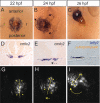Zebrafish as a model to study cardiac development and human cardiac disease
- PMID: 21602174
- PMCID: PMC3125074
- DOI: 10.1093/cvr/cvr098
Zebrafish as a model to study cardiac development and human cardiac disease
Abstract
Over the last decade, the zebrafish has entered the field of cardiovascular research as a new model organism. This is largely due to a number of highly successful small- and large-scale forward genetic screens, which have led to the identification of zebrafish mutants with cardiovascular defects. Genetic mapping and identification of the affected genes have resulted in novel insights into the molecular regulation of vertebrate cardiac development. More recently, the zebrafish has become an attractive model to study the effect of genetic variations identified in patients with cardiovascular defects by candidate gene or whole-genome-association studies. Thanks to an almost entirely sequenced genome and high conservation of gene function compared with humans, the zebrafish has proved highly informative to express and study human disease-related gene variants, providing novel insights into human cardiovascular disease mechanisms, and highlighting the suitability of the zebrafish as an excellent model to study human cardiovascular diseases. In this review, I discuss recent discoveries in the field of cardiac development and specific cases in which the zebrafish has been used to model human congenital and acquired cardiac diseases.
Figures


References
-
- Stainier DY, Lee RK, Fishman MC. Cardiovascular development in the zebrafish. I. Myocardial fate map and heart tube formation. Development. 1993;119:31–40. - PubMed
-
- Keegan BR, Meyer D, Yelon D. Organization of cardiac chamber progenitors in the zebrafish blastula. Development. 2004;131:3081–3091. doi:10.1242/dev.01185. - DOI - PubMed
-
- Keegan BR, Feldman JL, Begemann G, Ingham PW, Yelon D. Retinoic acid signaling restricts the cardiac progenitor pool. Science. 2005;307:247–249. doi:10.1126/science.1101573. - DOI - PubMed
-
- Kishimoto Y, Lee KH, Zon L, Hammerschmidt M, Schulte-Merker S. The molecular nature of zebrafish swirl: BMP2 function is essential during early dorsoventral patterning. Development. 1997;124:4457–4466. - PubMed
-
- Prall OWJ, Menon MK, Solloway MJ, Watanabe Y, Zaffran S, Bajolle F, et al. An Nkx2-5/Bmp2/Smad1 negative feedback loop controls heart progenitor specification and proliferation. Cell. 2007;128:947–959. doi:10.1016/j.cell.2007.01.042. - DOI - PMC - PubMed
Publication types
MeSH terms
LinkOut - more resources
Full Text Sources
Medical

